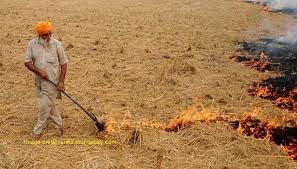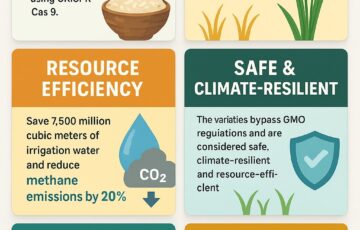Governmentality and Market Failures: The Stubble Burning Crisis
Syllabus:
GS-1:
Land ResourcesConservation of Resources
GS-2:
Government Policies & Interventions
Focus:
A recent study examines how India’s neoliberal agricultural policies and governmentality exacerbate stubble burning, contributing to severe air pollution. It highlights the systemic issues in agricultural marketing that force farmers into unsustainable practices, urging the government to implement comprehensive solutions for long-term environmental and economic health.
Understanding Stubble Burning:
- Stubble burning refers to the practice where farmers burn paddy crop residues to prepare land for the next crop cycle. This typically happens during October and November and is a primary contributor to air pollution in North India, particularly in Delhi, Punjab, Haryana, and surrounding regions.
- Impact of Stubble Burning: It significantly worsens air quality, contributing to toxic particulate matter (PM2.5) levels and creating a smog layer in cities. Despite its environmental impact, stubble burning remains a common practice due to economic and policy constraints faced by farmers.
Related Initiatives to Combat Stubble Burning:
○ Punjab, NCR States, and Delhi: Developed detailed, monitorable action plans under the Commission for Air Quality Management (CAQM) framework to address air pollution caused by stubble burning. ○ The action plans focus on effective management of crop residue and the enforcement of laws to reduce air pollution.
○ CAQM is a statutory body formed under the Commission for Air Quality Management in National Capital Region and Adjoining Areas, Act 2021. ○ Initially formed through an ordinance in 2021, it replaced the Environment Pollution Prevention and Control Authority (EPCA). ○ CAQM aims to improve air quality management in the National Capital Region (NCR) and nearby areas by coordinating efforts, conducting research, and resolving air quality issues.
○ In-situ Crop Residue Management: ■ Includes procurement of machines, setting up Custom Hiring Centers (CHCs), introducing high-yield paddy varieties, and using bio-decomposers. ○ Ex-situ Crop Residue Management: ■ Utilizes paddy straw in biomass power projects, thermal power plants, ethanol plants, and compressed biogas plants. ○ Prohibition of Stubble Burning: ■ Focus on monitoring, enforcement, and environmental compensation for farmers who burn stubble.
○ Sub-Mission on Agriculture Mechanization (SMAM) provides financial assistance to small and marginal farmers for purchasing machinery and equipment for crop residue management.
○ Uttar Pradesh: Launched the “Parali Ke Badle Govansh Khaad” program, where cow manure is exchanged for stubble, promoting sustainable farming. ○ Punjab: ■ Mobile apps like i-Khet help farmers access crop residue management machinery. ■ Cooperative Machinery Tracker ensures availability of CRM machines for stubble management. |
Governmentality and Market Failure:
- Understanding ‘Governmentality’: The concept of ‘governmentality’, introduced by French philosopher Michel Foucault, describes how governments influence citizens to regulate their own behavior without direct coercion. In the context of Indian agriculture, this has led to policies that push farmers toward practices like stubble burning.
- State’s Role in Promoting Stubble Burning: Government policies such as the Minimum Support Price (MSP) guarantee prices for wheat and rice but inadvertently encourage monoculture farming. This leads to reliance on unsustainable practices, including stubble burning, to clear the land for the next crop.
- Neoliberal Policies and Their Contradictions: India’s neoliberal policies create a cycle of marginalization for farmers. While the state promises guaranteed prices, it fails to offer affordable alternatives for dealing with crop residues, indirectly forcing farmers to burn stubble as a quick, low-cost method.
Farmers’ Perspectives on Policy:
- Farmers’ Struggle with Policy: Through interviews with 18 farmers across Punjab, the study reveals that farmers see the state as favoring urban-industrial interests, which are not subjected to the same scrutiny as agricultural practices. Despite penalties for stubble burning, there are no practical solutions provided for the disposal of crop residues.
- Dependency on Middlemen: Many farmers are indebted to middlemen (arhatias) who control the market for agricultural produce, credit, and price setting. These middlemen often exploit farmers by offering low prices for their crops while reselling at higher rates, further deepening their financial struggles.
- Economic Pressures: Stagnant MSP rates have failed to keep pace with rising production costs, leaving farmers unable to afford the resources required for sustainable farming. This economic pressure exacerbates the problem of stubble burning, as farmers see no better alternative for clearing their fields.
Systemic Causes of Stubble Burning:
- Distorted Agricultural Marketing System: The study reframes stubble burning not as individual neglect but as a systemic outcome of India’s agricultural marketing system. The government’s failure to address inefficiencies in the pricing and procurement system forces farmers to resort to harmful practices.
- A Cycle of Marginalization: The combination of poor policy incentives, limited financial support, and a lack of infrastructure to process stubble waste traps farmers in a cycle of dependence and poor decision-making, with stubble burning being one of the most visible and damaging outcomes.
Plausible Remedies and Policy Interventions:
- Developing a Market for Stubble: The study suggests creating a market for stubble-based products, such as fodder, energy products like pellets, and packaging materials. This would not only help farmers earn additional income but also address the environmental impact of stubble burning by finding productive uses for the residue.
- Strengthening the Value Chain: An efficient market mechanism for farm waste is critical. The government must take proactive steps to create an ecosystem that supports the collection, processing, and commercialization of stubble. This involves technological innovation and stronger market linkages to ensure farmers can profit from stubble recycling.
- Regulatory Interventions: The government could regulate stubble burning in three ways: outright prohibition, selective permitting, or incentivizing the use of stubble for alternative products. The latter would require active government involvement and substantial policy shifts to encourage farmers to adopt more sustainable practices.
- Ensuring Fair Prices for Farmers: One of the key interventions proposed is addressing the inefficiencies in India’s agricultural commodity markets. The government needs to enhance price transparency and fairness to ensure that farmers are not exploited by middlemen and can receive fair compensation for their crops.
- A Cultural Shift in Aspirational Consumption: Socio-economic pressures on farmers often result in an aspirational consumption pattern that may be detrimental to their financial stability. Promoting a cultural shift through community organizations, including religious groups, could help reduce non-essential consumption and allow farmers to focus on their basic needs rather than external pressures.
Way Forward:
- Multi-Level Policy Interventions: The government must take a comprehensive approach that combines regulatory measures with incentives for sustainable practices. Ensuring farmers receive fair compensation for their produce and developing alternative uses for stubble will help reduce the need for stubble burning.
- Long-Term Support for Farmers: In addition to immediate solutions, the government needs to invest in long-term agricultural reforms that allow farmers to diversify crops, access better technologies, and become less reliant on unsustainable practices.
Conclusion:
- Reframing the Stubble Burning Issue: The study highlights that stubble burning is not simply a matter of farmer negligence but is deeply intertwined with India’s broader economic and policy landscape. It is a symptom of market failures, inadequate policy support, and a lack of viable alternatives for farmers.
- Need for Holistic Solutions: To tackle the problem effectively, a multi-faceted approach is necessary. This includes addressing the root causes of stubble burning through systemic market reforms, better agricultural policies, and the creation of alternative markets for stubble. Moreover, the role of the state in incentivizing sustainable practices and providing long-term solutions will be crucial in mitigating this environmental
- Role of Stakeholders: The government, market players, and civil society organizations must work together to build a sustainable ecosystem for agriculture in India. Only by addressing the structural challenges within the agricultural marketing system can the issue of stubble burning be permanently solved.
Source: TH
Mains Practice Question:
Question: Examine how India’s neoliberal agricultural policies and the concept of governmentality contribute to the widespread practice of stubble burning. What steps can be taken to address the systemic causes of stubble burning and promote sustainable agricultural practices? Discuss with reference to recent studies on the issue.






